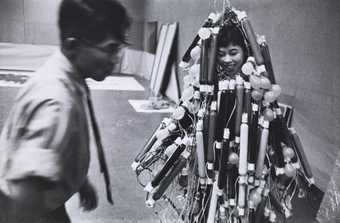
Kiyoji Otsuji, Tanaka Atsuko, Electric Dress, 2nd Gutai Exhibition 1956, printed 2012. Tate. © reserved.
Gutai
8 rooms in Performer and Participant
Learn how the Gutai artists playfully experimented with expanded forms of painting, performance and installation
The Gutai Bijutsu Kyokai (Gutai Art Association) was founded by Yoshihara Jirō in 1954. The group was based in the city of Ashiya, in western Japan. The spirit of the individual was central to their philosophy. During the Second World War, Japan’s totalitarian regime had promoted a unified national identity. Personal expression was stifled. Following the war, Gutai pursued artistic experimentation, freedom and individuality. Yosihara called on members to ‘do what no one has done before!’
Gutai means the physical embodiment of an idea. The term comes from ‘gu’, meaning tool or a way of doing something, and ‘tai’ meaning a body. Actions and materials were equally important to the artists. Although they worked in different styles, Gutai artists were united by their experimental approaches. They rejected traditional methods of making, choosing to paint with bare feet, watering cans, homemade cannons and even remote-controlled machines. Their artworks or ‘performance paintings’ live on as records of the actions that produced them. The acts of making remain as significant as the resulting artworks.
The group further disrupted tradition by staging exhibitions outside the confines of the gallery. They held exhibitions in public parks, on stage, even in the sky. Much of their work was site-specific and ephemeral, aiming to ‘bring art into lived time’. Today these works exist only as documentary photographs, many of which are included in this display.
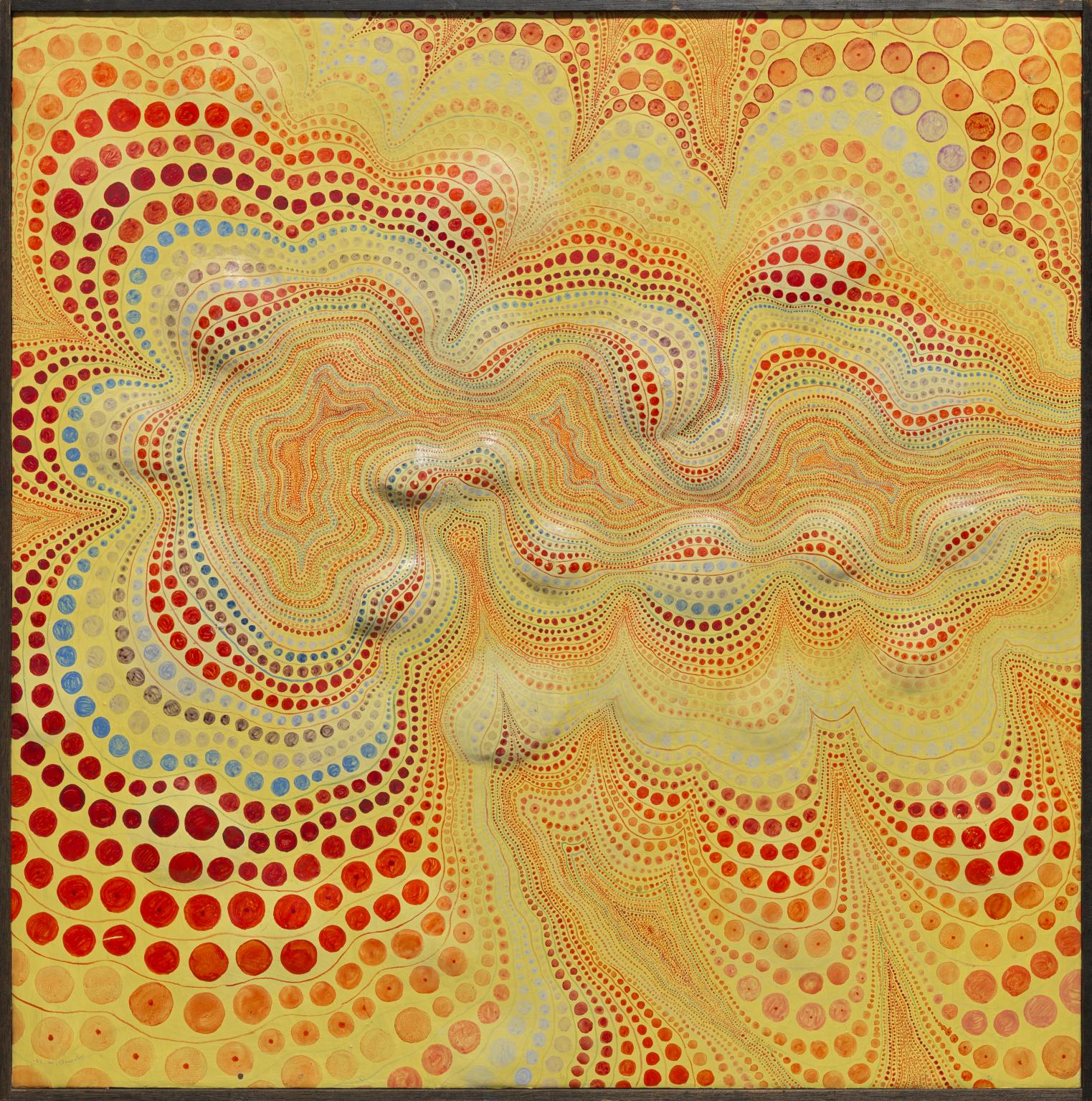
Minoru Onoda, WORK62-W 1962
Onoda Minoru was part of the second generation of Gutai artists. He began making paintings using dots of various sizes and colours in 1961. Onoda described these as ‘propagation paintings’. For him, the systematic repetition of dots was a way to think mechanically. Through this technique, he hoped to counter the subjectivity of action-based painting. Onoda was also responding to the industrialisation of Japan during the post-war period. He found inspiration in the ‘vast meaninglessness’ of machine-made, identically duplicated objects.
Gallery label, December 2020
1/24
artworks in Gutai
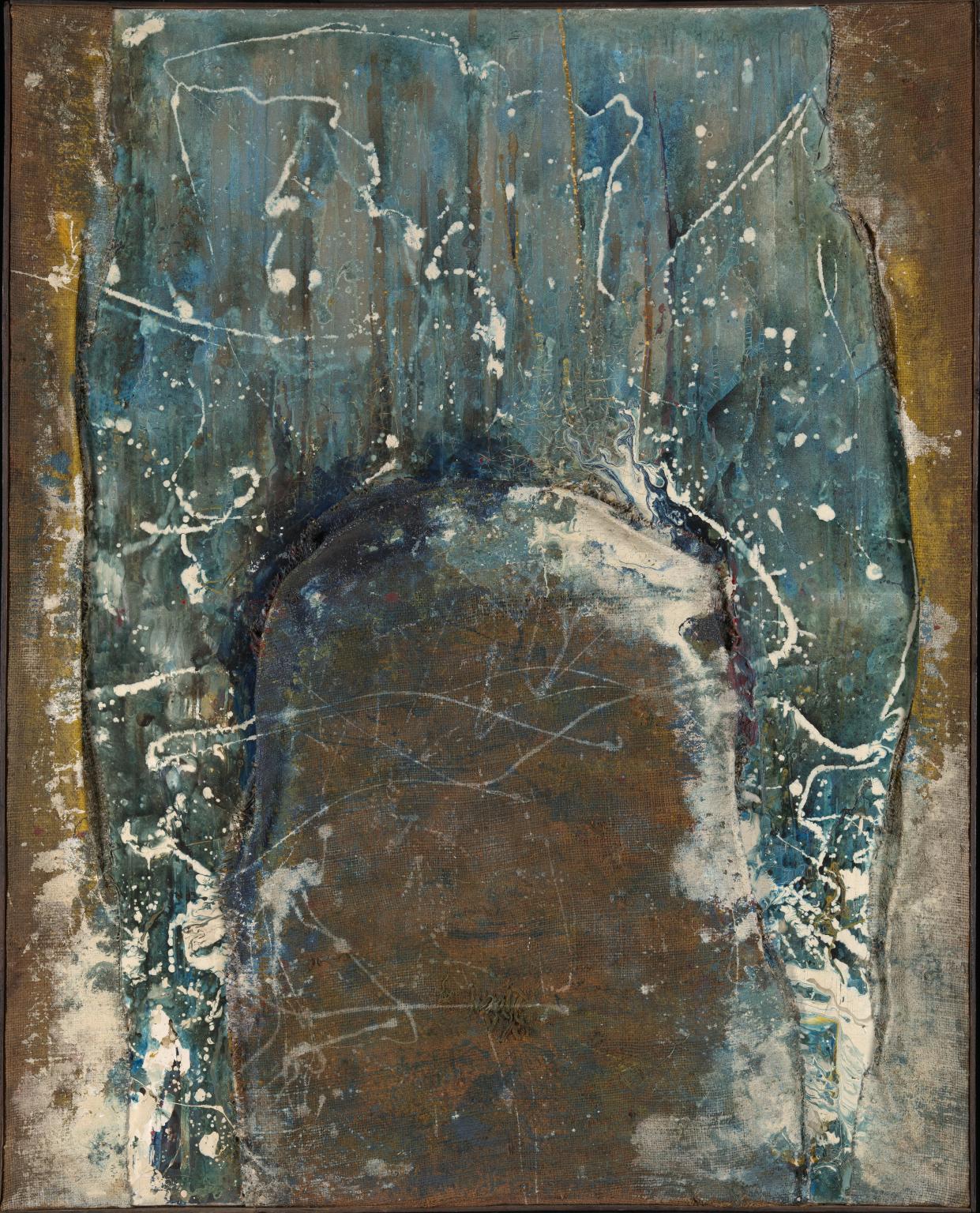
Tsuyoshi Maekawa, Two Junctions 1962
To create Two Junctions, Maekawa placed pieces of burlap, a textile used to make rice bags, onto a canvas. He then cut, sewed and folded the material. Finally, he poured and dripped coloured enamel paint over the textured surface. This produced an abstract image that moves beyond the flatness traditionally associated with painting. Maekawa was a prominent member of The Gutai Art Association. This was a group of artists working in Japan from 1954-1972. Industrial and everyday materials feature in much of their work. They were also interested in how the act of painting relates to performance.
Gallery label, June 2020
2/24
artworks in Gutai
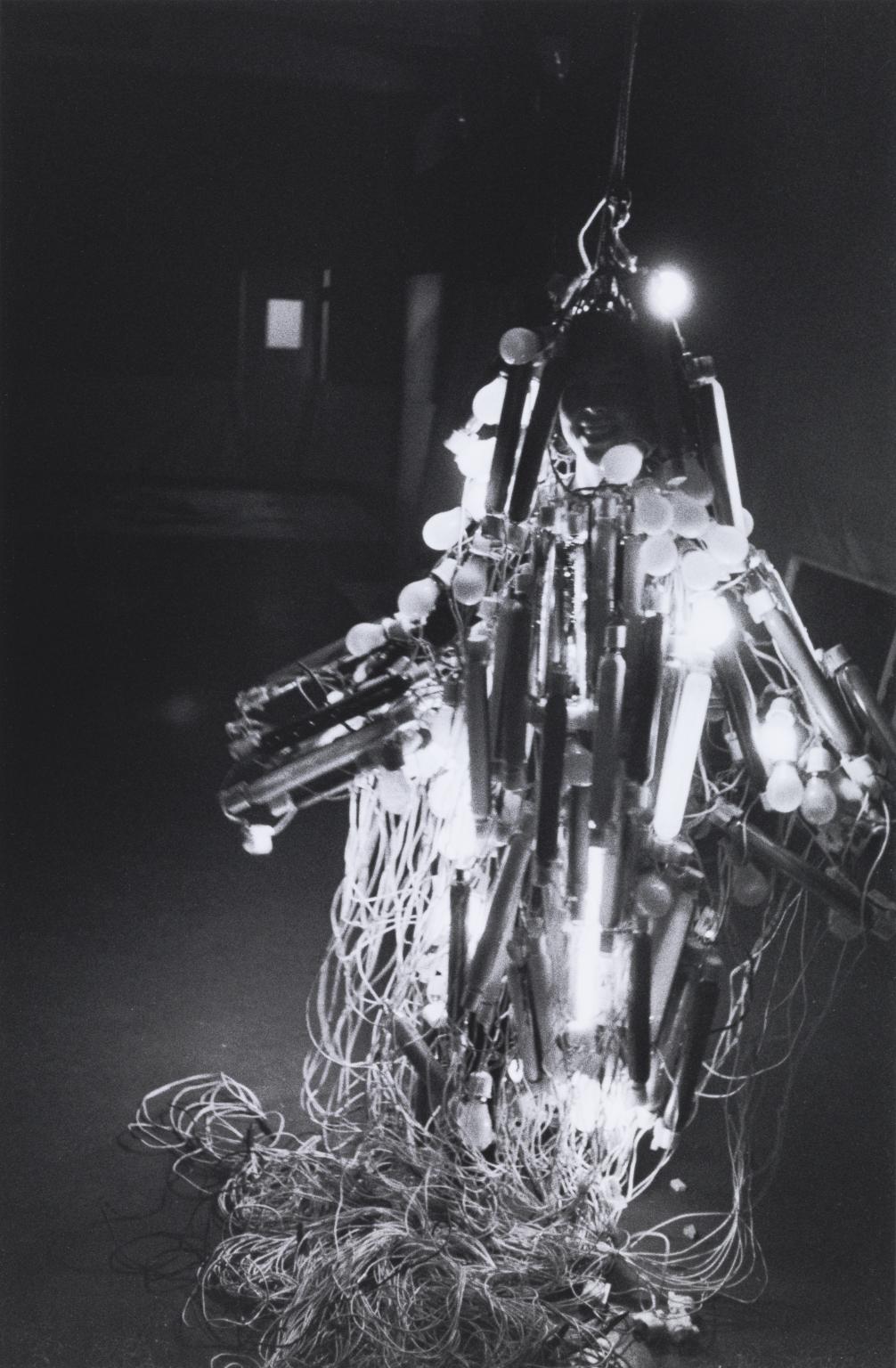
Kiyoji Otsuji, Tanaka Atsuko, Electric Dress, 2nd Gutai Exhibition 1956, printed 2012
This photograph is from the Japanese photographer Kiyoji Otsuji’s portfolio of forty-eight photographs known collectively as the Gutai Portfolio (Tate P82274–321). The portfolio comprises forty-eight black and white photographs, printed posthumously in 2012 with permission from the artist’s estate from negatives which were made between 1956 and 1957. This set is the seventh in an edition of seventeen; there also exist three artist’s proofs (other editions of the portfolio are in the collections of the Inhotim Institute in Brumadinho, Brazil and The Dallas Museum of Art). The series of images document emblematic works by members of the Japanese Gutai group, such as Tanaka Atsuko’s (born 1932) Electric Dress 1956 and Murakami Saburo’s (1925–1996) performance Passing Through 1956; such images are at times the only remaining manifestation of the often ephemeral work and actions of the Gutai artists and, as such, have been used to represent their work in publications and exhibitions about the group. The portfolio can be divided into twelve groups of images relating to performative actions that were conceived either as part of the production process for an artwork, or which constituted the work of art in itself. They relate to two landmark Gutai exhibitions: the 2nd Gutai Exhibition at Ohara Kaikan, Tokyo, circa 11–17 October 1956, and the Gutai Art on the Stage exhibition at the Sankei Kaikan halls in Osaka and Tokyo in 1957.
3/24
artworks in Gutai
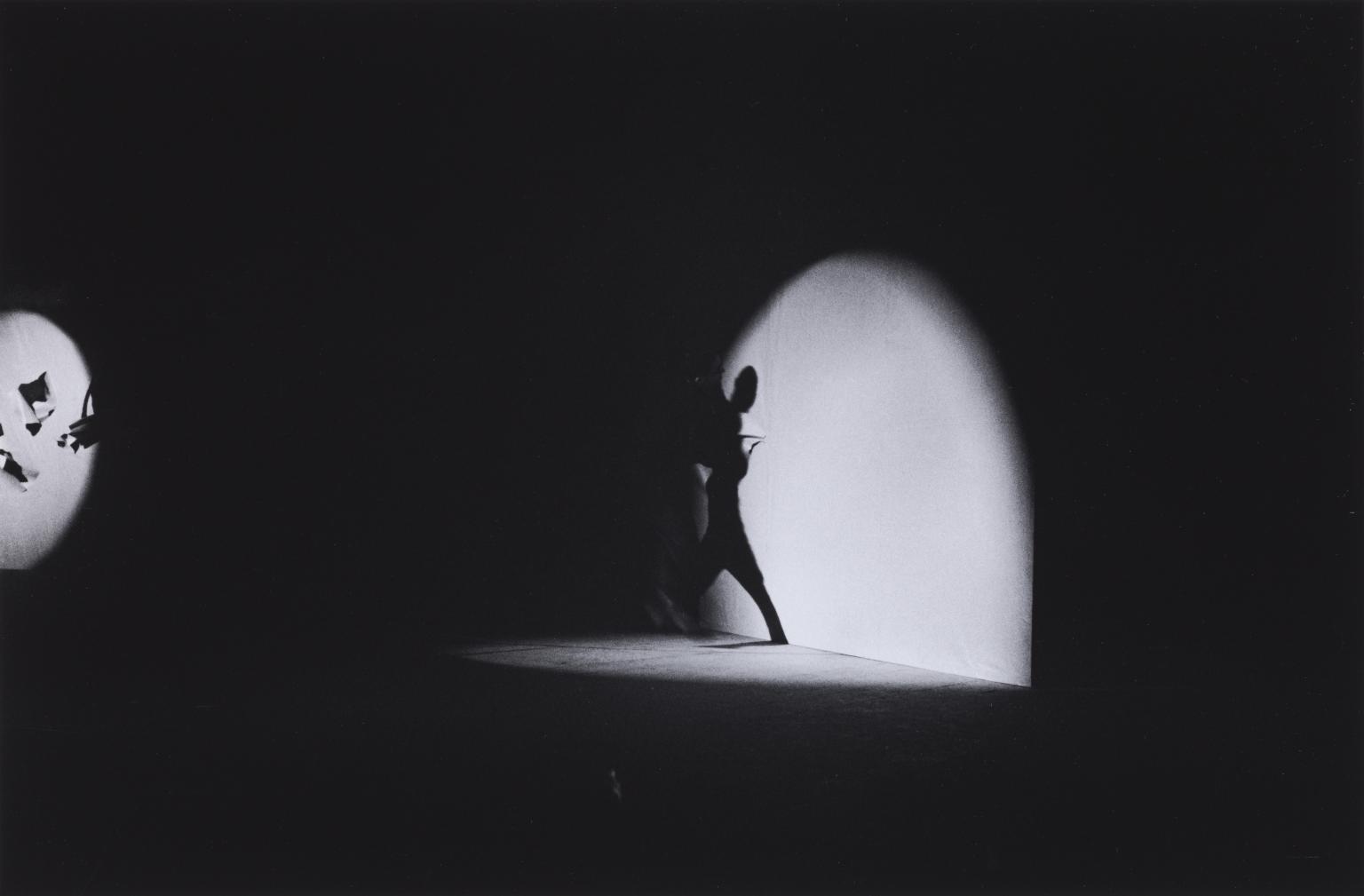
Kiyoji Otsuji, Murakami Saburo, Wrestling with Folding Screen, Gutai Exhibition on the Stage 1957, printed 2012
This photograph is from the Japanese photographer Kiyoji Otsuji’s portfolio of forty-eight photographs known collectively as the Gutai Portfolio (Tate P82274–321). The portfolio comprises forty-eight black and white photographs, printed posthumously in 2012 with permission from the artist’s estate from negatives which were made between 1956 and 1957. This set is the seventh in an edition of seventeen; there also exist three artist’s proofs (other editions of the portfolio are in the collections of the Inhotim Institute in Brumadinho, Brazil and The Dallas Museum of Art). The series of images document emblematic works by members of the Japanese Gutai group, such as Tanaka Atsuko’s (born 1932) Electric Dress 1956 and Murakami Saburo’s (1925–1996) performance Passing Through 1956; such images are at times the only remaining manifestation of the often ephemeral work and actions of the Gutai artists and, as such, have been used to represent their work in publications and exhibitions about the group. The portfolio can be divided into twelve groups of images relating to performative actions that were conceived either as part of the production process for an artwork, or which constituted the work of art in itself. They relate to two landmark Gutai exhibitions: the 2nd Gutai Exhibition at Ohara Kaikan, Tokyo, circa 11–17 October 1956, and the Gutai Art on the Stage exhibition at the Sankei Kaikan halls in Osaka and Tokyo in 1957.
4/24
artworks in Gutai

Shozo Shimamoto, Holes 1954
Holes is made from layers of newspaper. Shimamoto painted the surface white with areas of pale blue. He then pierced it to reveal the different layers underneath. Shimamoto began the series around 1949 or 50. This was during the North American occupation of Japan after the end of the Second World War. The contrast between delicate paintwork and violent holes in its surface may reflect the disruption of traditional Japanese culture as a result of the war. Shimamoto founded the radical artist group the Gutair Association in 1954. Finding a balance between destruction and creativity was a key focus in their work.
Gallery label, August 2020
5/24
artworks in Gutai
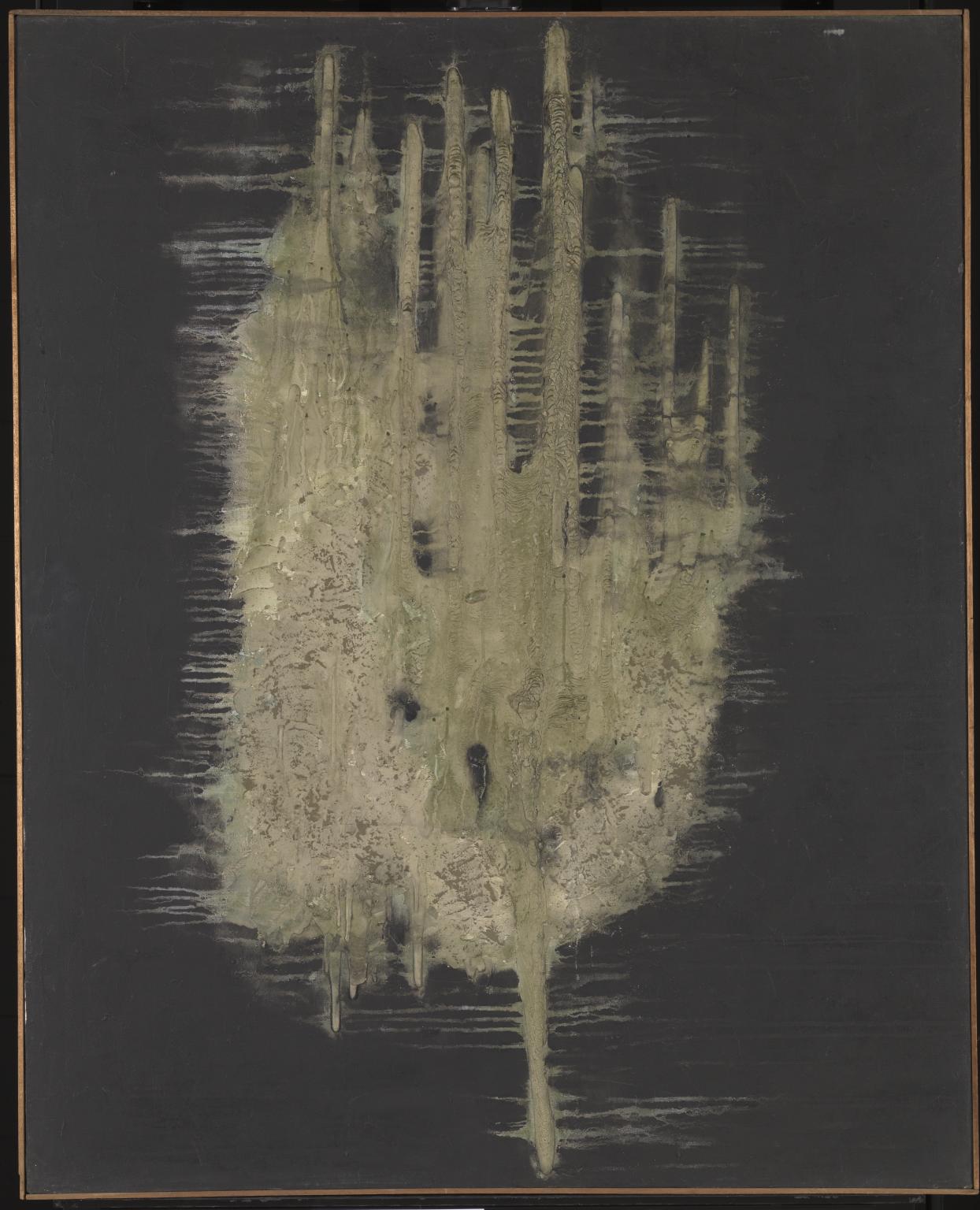
Ryuji Tanaka, Sei (9) 1962–3
Tanaka Ryūji studied nihonga, a traditional form of Japanese painting, at the Kyoto Municipal School of Painting. Shiraga Kazuo, another Gutai artist, also studied with him. In nihonga, glue is mixed with the pigment to act as a fixing agent. This is then applied with a brush. In this work Tanaka challenged the traditional nihonga style and technique by adding pebbles to his mineral pigments and using a feather to apply the paint.
Gallery label, December 2020
6/24
artworks in Gutai
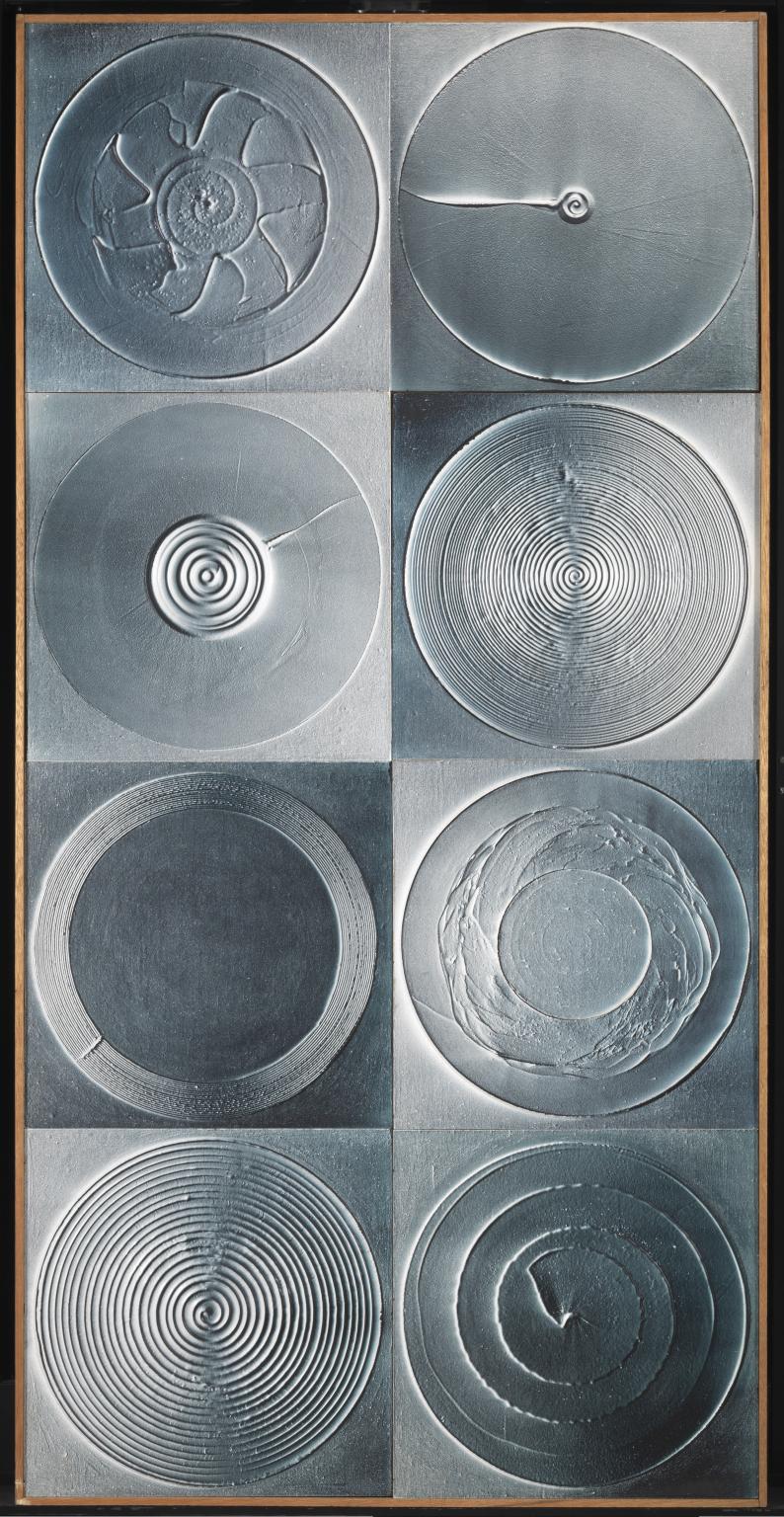
Yuko Nasaka, Untitled 1964
This work is comprised of eight plaster panels. Nasaka Yūko placed each one onto a mechanical turntable, inspired by the potter’s wheel. As it rotated, she carved patterns into the plaster using a palette knife. She then applied a layer of dark-blue silver lacquer to the surface. Nasaka was part of the second generation of Gutai artists who experimented with technology. Much of their work used industrial materials and techniques, referencing Japan’s rapid economic growth.
Gallery label, December 2020
7/24
artworks in Gutai
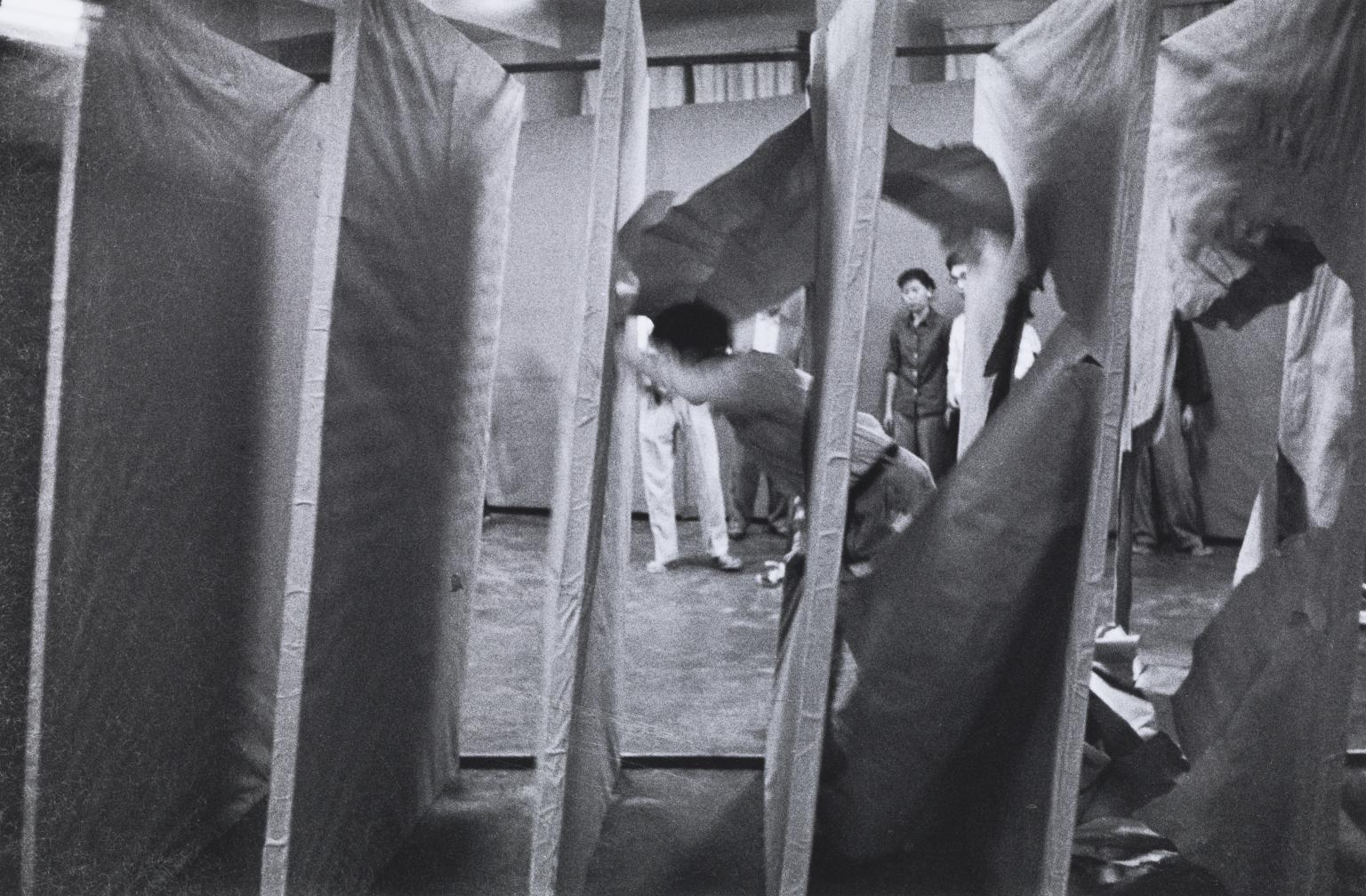
Kiyoji Otsuji, Murakami Saburo, Passing Through, 2nd Gutai Art exhibition 1956, printed 2012
This photograph is from the Japanese photographer Kiyoji Otsuji’s portfolio of forty-eight photographs known collectively as the Gutai Portfolio (Tate P82274–321). The portfolio comprises forty-eight black and white photographs, printed posthumously in 2012 with permission from the artist’s estate from negatives which were made between 1956 and 1957. This set is the seventh in an edition of seventeen; there also exist three artist’s proofs (other editions of the portfolio are in the collections of the Inhotim Institute in Brumadinho, Brazil and The Dallas Museum of Art). The series of images document emblematic works by members of the Japanese Gutai group, such as Tanaka Atsuko’s (born 1932) Electric Dress 1956 and Murakami Saburo’s (1925–1996) performance Passing Through 1956; such images are at times the only remaining manifestation of the often ephemeral work and actions of the Gutai artists and, as such, have been used to represent their work in publications and exhibitions about the group. The portfolio can be divided into twelve groups of images relating to performative actions that were conceived either as part of the production process for an artwork, or which constituted the work of art in itself. They relate to two landmark Gutai exhibitions: the 2nd Gutai Exhibition at Ohara Kaikan, Tokyo, circa 11–17 October 1956, and the Gutai Art on the Stage exhibition at the Sankei Kaikan halls in Osaka and Tokyo in 1957.
8/24
artworks in Gutai

Kiyoji Otsuji, Murakami Saburo, Passing Through, 2nd Gutai Art exhibition 1956, printed 2012
This photograph is from the Japanese photographer Kiyoji Otsuji’s portfolio of forty-eight photographs known collectively as the Gutai Portfolio (Tate P82274–321). The portfolio comprises forty-eight black and white photographs, printed posthumously in 2012 with permission from the artist’s estate from negatives which were made between 1956 and 1957. This set is the seventh in an edition of seventeen; there also exist three artist’s proofs (other editions of the portfolio are in the collections of the Inhotim Institute in Brumadinho, Brazil and The Dallas Museum of Art). The series of images document emblematic works by members of the Japanese Gutai group, such as Tanaka Atsuko’s (born 1932) Electric Dress 1956 and Murakami Saburo’s (1925–1996) performance Passing Through 1956; such images are at times the only remaining manifestation of the often ephemeral work and actions of the Gutai artists and, as such, have been used to represent their work in publications and exhibitions about the group. The portfolio can be divided into twelve groups of images relating to performative actions that were conceived either as part of the production process for an artwork, or which constituted the work of art in itself. They relate to two landmark Gutai exhibitions: the 2nd Gutai Exhibition at Ohara Kaikan, Tokyo, circa 11–17 October 1956, and the Gutai Art on the Stage exhibition at the Sankei Kaikan halls in Osaka and Tokyo in 1957.
9/24
artworks in Gutai
Sorry, no image available
Kiyoji Otsuji, Murakami Saburo, Passing Through, 2nd Gutai Art exhibition 1956, printed 2012
This photograph is from the Japanese photographer Kiyoji Otsuji’s portfolio of forty-eight photographs known collectively as the Gutai Portfolio (Tate P82274–321). The portfolio comprises forty-eight black and white photographs, printed posthumously in 2012 with permission from the artist’s estate from negatives which were made between 1956 and 1957. This set is the seventh in an edition of seventeen; there also exist three artist’s proofs (other editions of the portfolio are in the collections of the Inhotim Institute in Brumadinho, Brazil and The Dallas Museum of Art). The series of images document emblematic works by members of the Japanese Gutai group, such as Tanaka Atsuko’s (born 1932) Electric Dress 1956 and Murakami Saburo’s (1925–1996) performance Passing Through 1956; such images are at times the only remaining manifestation of the often ephemeral work and actions of the Gutai artists and, as such, have been used to represent their work in publications and exhibitions about the group. The portfolio can be divided into twelve groups of images relating to performative actions that were conceived either as part of the production process for an artwork, or which constituted the work of art in itself. They relate to two landmark Gutai exhibitions: the 2nd Gutai Exhibition at Ohara Kaikan, Tokyo, circa 11–17 October 1956, and the Gutai Art on the Stage exhibition at the Sankei Kaikan halls in Osaka and Tokyo in 1957.
10/24
artworks in Gutai
Sorry, no image available
Kiyoji Otsuji, Murakami Saburo, Passing Through, 2nd Gutai Art exhibition 1956, printed 2012
This photograph is from the Japanese photographer Kiyoji Otsuji’s portfolio of forty-eight photographs known collectively as the Gutai Portfolio (Tate P82274–321). The portfolio comprises forty-eight black and white photographs, printed posthumously in 2012 with permission from the artist’s estate from negatives which were made between 1956 and 1957. This set is the seventh in an edition of seventeen; there also exist three artist’s proofs (other editions of the portfolio are in the collections of the Inhotim Institute in Brumadinho, Brazil and The Dallas Museum of Art). The series of images document emblematic works by members of the Japanese Gutai group, such as Tanaka Atsuko’s (born 1932) Electric Dress 1956 and Murakami Saburo’s (1925–1996) performance Passing Through 1956; such images are at times the only remaining manifestation of the often ephemeral work and actions of the Gutai artists and, as such, have been used to represent their work in publications and exhibitions about the group. The portfolio can be divided into twelve groups of images relating to performative actions that were conceived either as part of the production process for an artwork, or which constituted the work of art in itself. They relate to two landmark Gutai exhibitions: the 2nd Gutai Exhibition at Ohara Kaikan, Tokyo, circa 11–17 October 1956, and the Gutai Art on the Stage exhibition at the Sankei Kaikan halls in Osaka and Tokyo in 1957.
11/24
artworks in Gutai
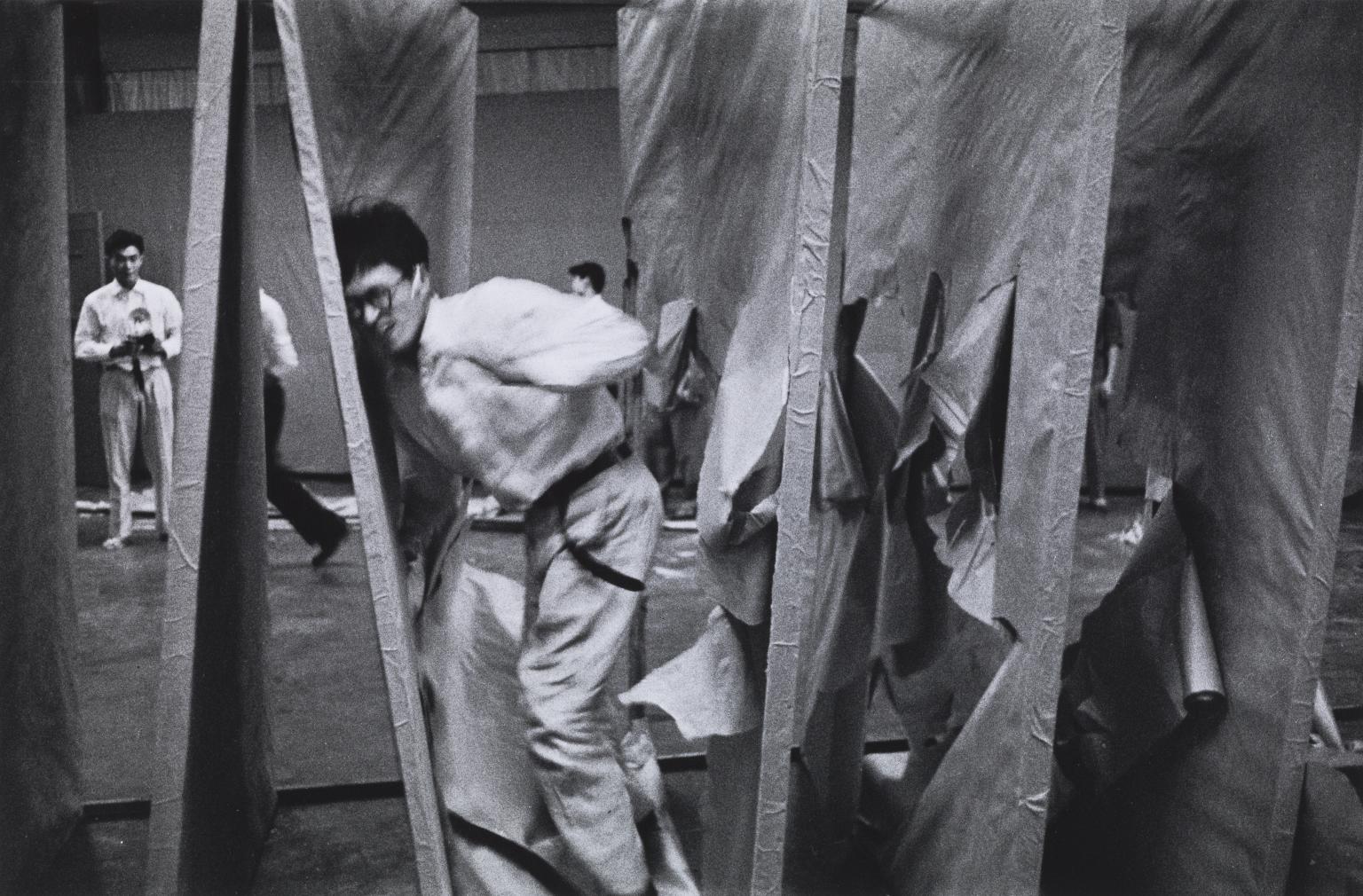
Kiyoji Otsuji, Murakami Saburo, Passing Through, 2nd Gutai Art exhibition 1956, printed 2012
This photograph is from the Japanese photographer Kiyoji Otsuji’s portfolio of forty-eight photographs known collectively as the Gutai Portfolio (Tate P82274–321). The portfolio comprises forty-eight black and white photographs, printed posthumously in 2012 with permission from the artist’s estate from negatives which were made between 1956 and 1957. This set is the seventh in an edition of seventeen; there also exist three artist’s proofs (other editions of the portfolio are in the collections of the Inhotim Institute in Brumadinho, Brazil and The Dallas Museum of Art). The series of images document emblematic works by members of the Japanese Gutai group, such as Tanaka Atsuko’s (born 1932) Electric Dress 1956 and Murakami Saburo’s (1925–1996) performance Passing Through 1956; such images are at times the only remaining manifestation of the often ephemeral work and actions of the Gutai artists and, as such, have been used to represent their work in publications and exhibitions about the group. The portfolio can be divided into twelve groups of images relating to performative actions that were conceived either as part of the production process for an artwork, or which constituted the work of art in itself. They relate to two landmark Gutai exhibitions: the 2nd Gutai Exhibition at Ohara Kaikan, Tokyo, circa 11–17 October 1956, and the Gutai Art on the Stage exhibition at the Sankei Kaikan halls in Osaka and Tokyo in 1957.
12/24
artworks in Gutai
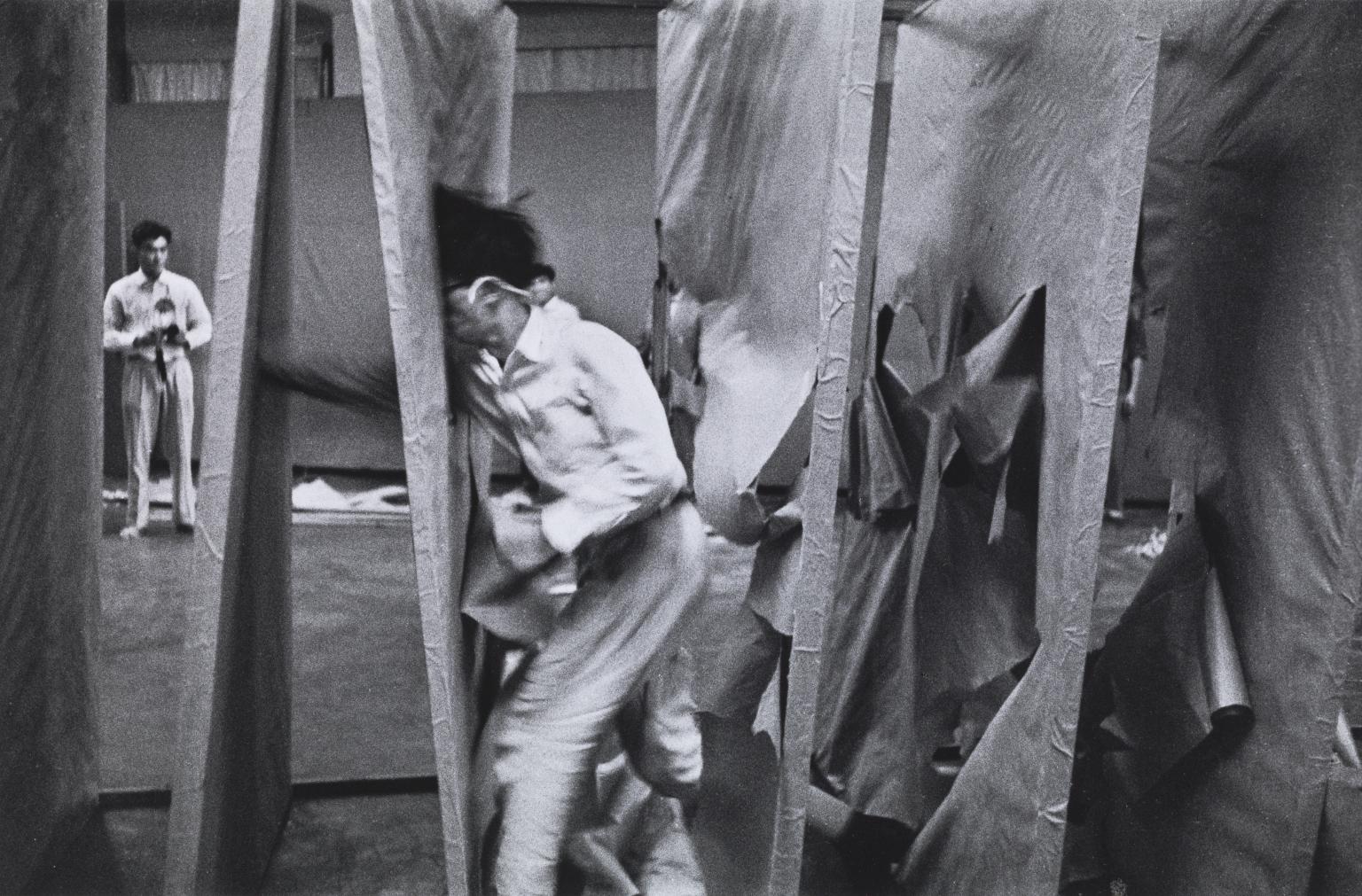
Kiyoji Otsuji, Murakami Saburo, Passing Through, 2nd Gutai Art exhibition 1956, printed 2012
This photograph is from the Japanese photographer Kiyoji Otsuji’s portfolio of forty-eight photographs known collectively as the Gutai Portfolio (Tate P82274–321). The portfolio comprises forty-eight black and white photographs, printed posthumously in 2012 with permission from the artist’s estate from negatives which were made between 1956 and 1957. This set is the seventh in an edition of seventeen; there also exist three artist’s proofs (other editions of the portfolio are in the collections of the Inhotim Institute in Brumadinho, Brazil and The Dallas Museum of Art). The series of images document emblematic works by members of the Japanese Gutai group, such as Tanaka Atsuko’s (born 1932) Electric Dress 1956 and Murakami Saburo’s (1925–1996) performance Passing Through 1956; such images are at times the only remaining manifestation of the often ephemeral work and actions of the Gutai artists and, as such, have been used to represent their work in publications and exhibitions about the group. The portfolio can be divided into twelve groups of images relating to performative actions that were conceived either as part of the production process for an artwork, or which constituted the work of art in itself. They relate to two landmark Gutai exhibitions: the 2nd Gutai Exhibition at Ohara Kaikan, Tokyo, circa 11–17 October 1956, and the Gutai Art on the Stage exhibition at the Sankei Kaikan halls in Osaka and Tokyo in 1957.
13/24
artworks in Gutai
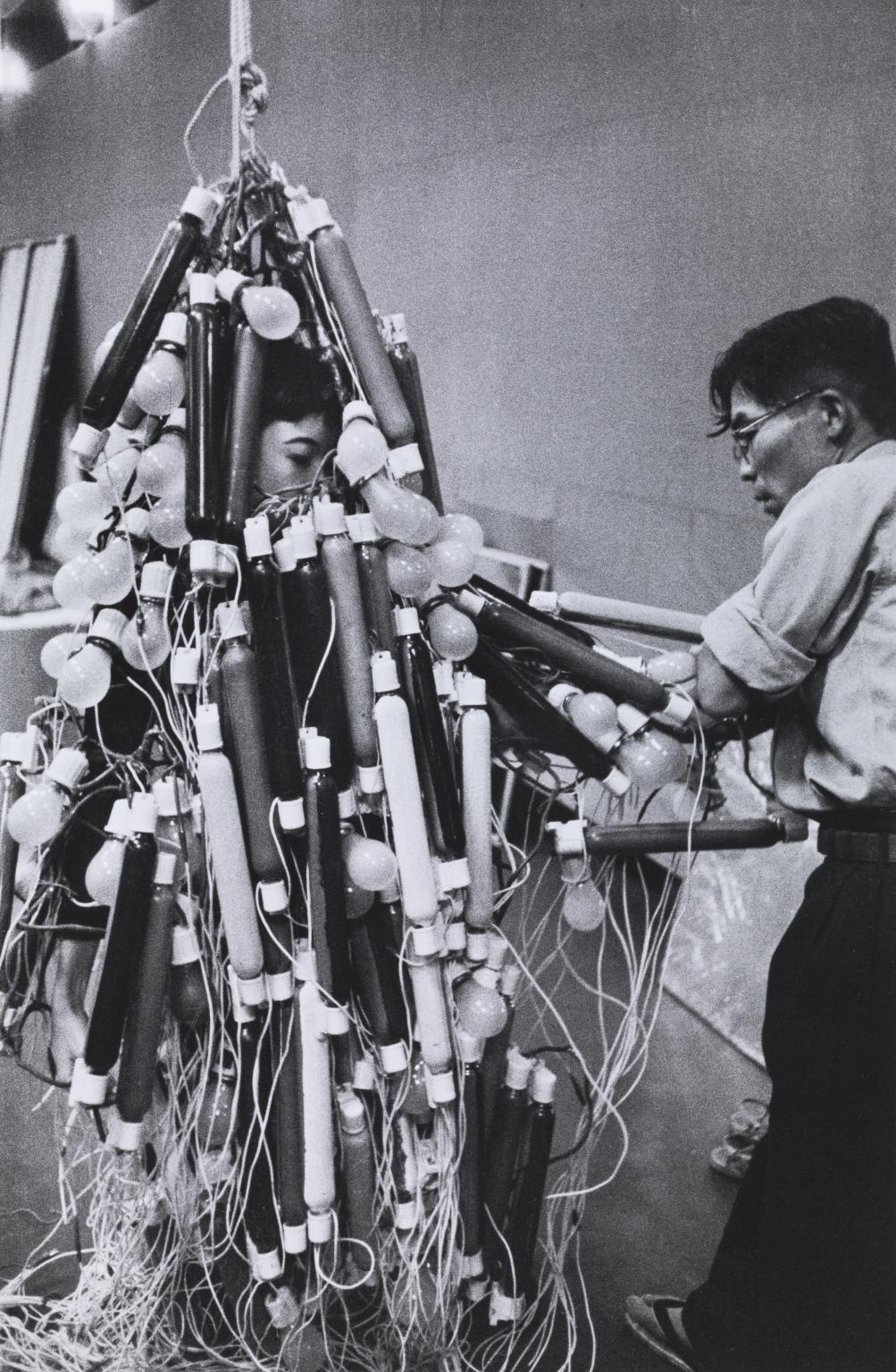
Kiyoji Otsuji, Tanaka Atsuko, Electric Dress, 2nd Gutai Exhibition 1956, printed 2012
This photograph is from the Japanese photographer Kiyoji Otsuji’s portfolio of forty-eight photographs known collectively as the Gutai Portfolio (Tate P82274–321). The portfolio comprises forty-eight black and white photographs, printed posthumously in 2012 with permission from the artist’s estate from negatives which were made between 1956 and 1957. This set is the seventh in an edition of seventeen; there also exist three artist’s proofs (other editions of the portfolio are in the collections of the Inhotim Institute in Brumadinho, Brazil and The Dallas Museum of Art). The series of images document emblematic works by members of the Japanese Gutai group, such as Tanaka Atsuko’s (born 1932) Electric Dress 1956 and Murakami Saburo’s (1925–1996) performance Passing Through 1956; such images are at times the only remaining manifestation of the often ephemeral work and actions of the Gutai artists and, as such, have been used to represent their work in publications and exhibitions about the group. The portfolio can be divided into twelve groups of images relating to performative actions that were conceived either as part of the production process for an artwork, or which constituted the work of art in itself. They relate to two landmark Gutai exhibitions: the 2nd Gutai Exhibition at Ohara Kaikan, Tokyo, circa 11–17 October 1956, and the Gutai Art on the Stage exhibition at the Sankei Kaikan halls in Osaka and Tokyo in 1957.
14/24
artworks in Gutai
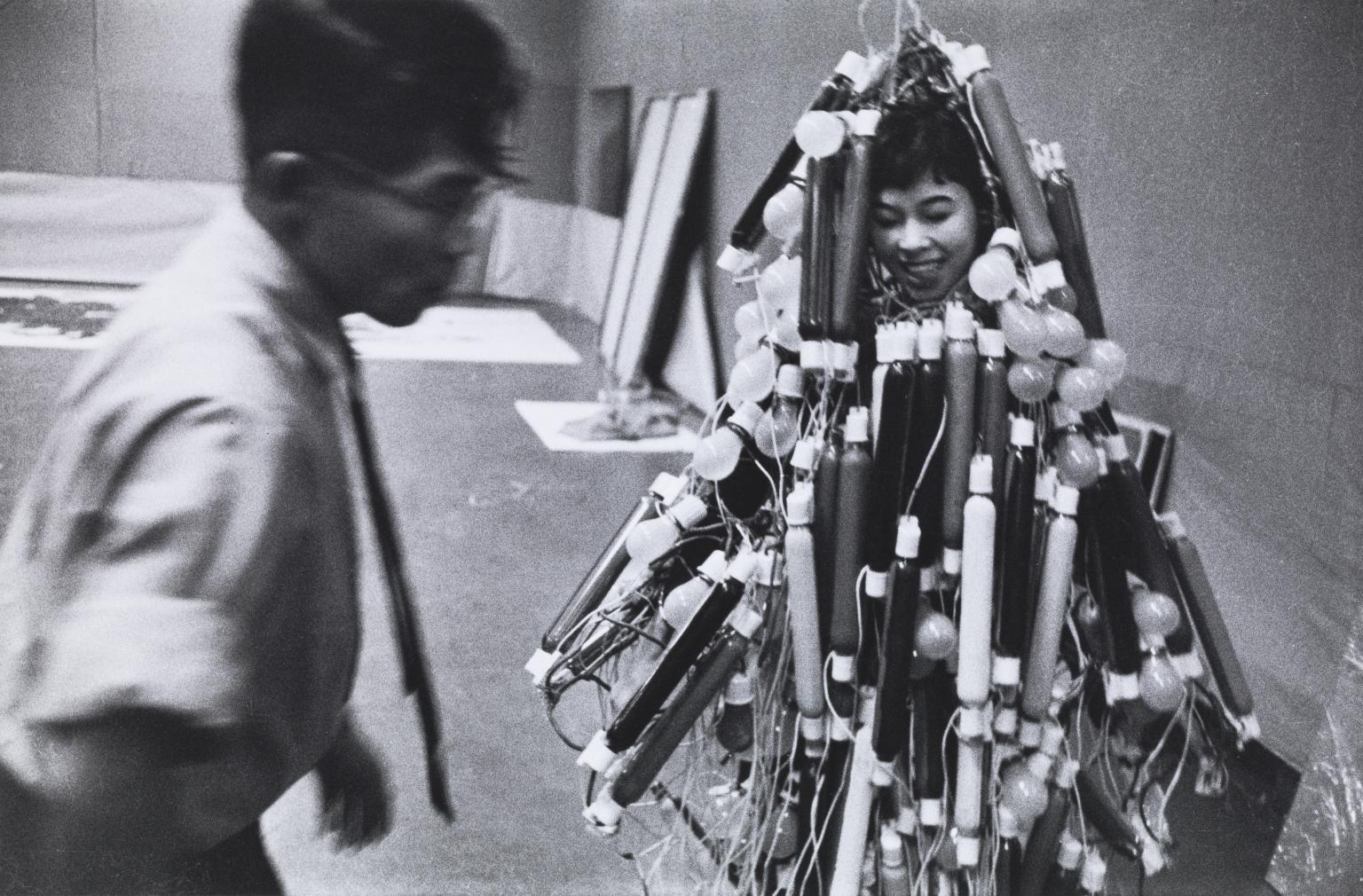
Kiyoji Otsuji, Tanaka Atsuko, Electric Dress, 2nd Gutai Exhibition 1956, printed 2012
This photograph is from the Japanese photographer Kiyoji Otsuji’s portfolio of forty-eight photographs known collectively as the Gutai Portfolio (Tate P82274–321). The portfolio comprises forty-eight black and white photographs, printed posthumously in 2012 with permission from the artist’s estate from negatives which were made between 1956 and 1957. This set is the seventh in an edition of seventeen; there also exist three artist’s proofs (other editions of the portfolio are in the collections of the Inhotim Institute in Brumadinho, Brazil and The Dallas Museum of Art). The series of images document emblematic works by members of the Japanese Gutai group, such as Tanaka Atsuko’s (born 1932) Electric Dress 1956 and Murakami Saburo’s (1925–1996) performance Passing Through 1956; such images are at times the only remaining manifestation of the often ephemeral work and actions of the Gutai artists and, as such, have been used to represent their work in publications and exhibitions about the group. The portfolio can be divided into twelve groups of images relating to performative actions that were conceived either as part of the production process for an artwork, or which constituted the work of art in itself. They relate to two landmark Gutai exhibitions: the 2nd Gutai Exhibition at Ohara Kaikan, Tokyo, circa 11–17 October 1956, and the Gutai Art on the Stage exhibition at the Sankei Kaikan halls in Osaka and Tokyo in 1957.
15/24
artworks in Gutai
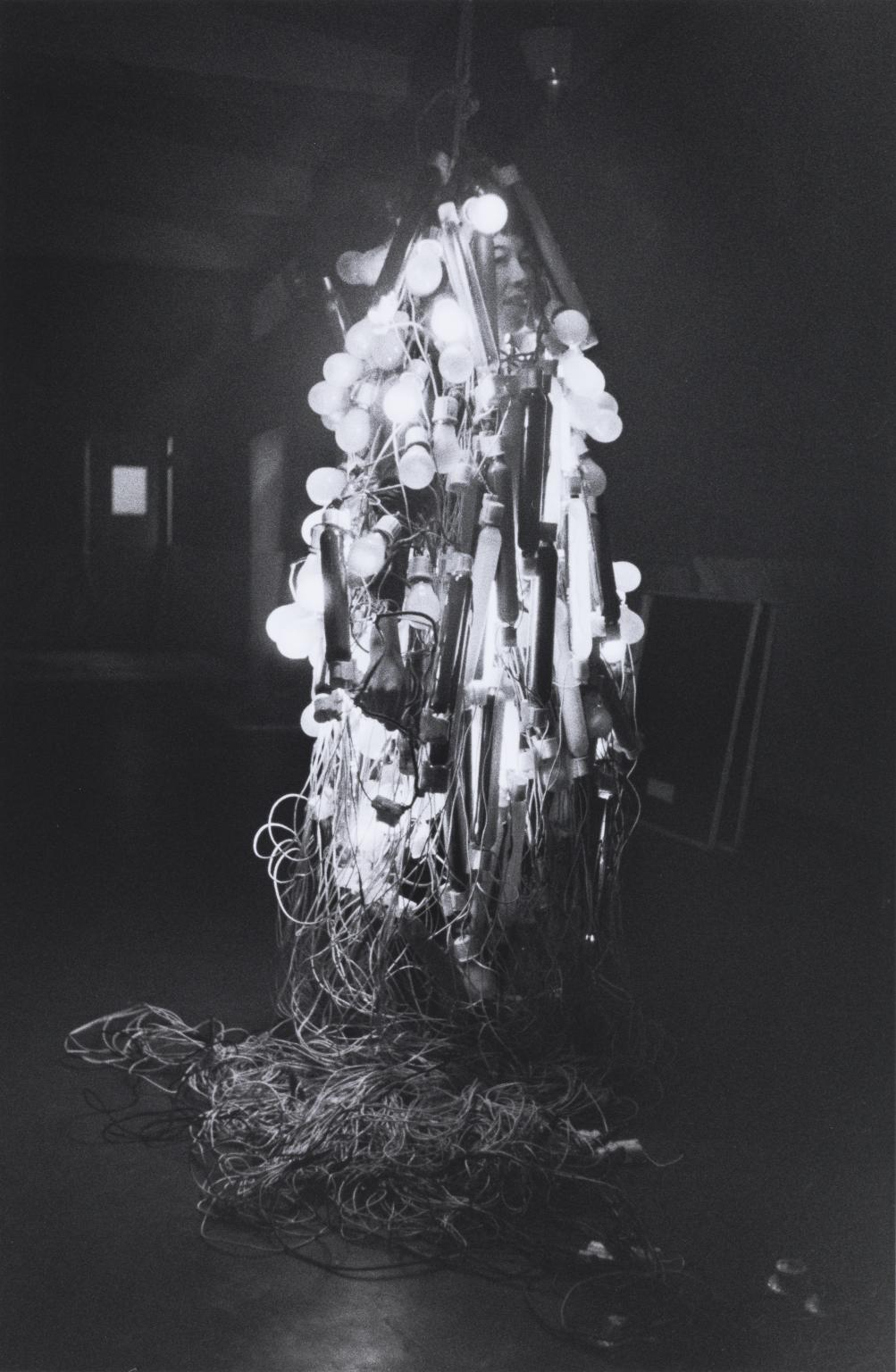
Kiyoji Otsuji, Tanaka Atsuko, Electric Dress, 2nd Gutai Exhibition 1956, printed 2012
This photograph is from the Japanese photographer Kiyoji Otsuji’s portfolio of forty-eight photographs known collectively as the Gutai Portfolio (Tate P82274–321). The portfolio comprises forty-eight black and white photographs, printed posthumously in 2012 with permission from the artist’s estate from negatives which were made between 1956 and 1957. This set is the seventh in an edition of seventeen; there also exist three artist’s proofs (other editions of the portfolio are in the collections of the Inhotim Institute in Brumadinho, Brazil and The Dallas Museum of Art). The series of images document emblematic works by members of the Japanese Gutai group, such as Tanaka Atsuko’s (born 1932) Electric Dress 1956 and Murakami Saburo’s (1925–1996) performance Passing Through 1956; such images are at times the only remaining manifestation of the often ephemeral work and actions of the Gutai artists and, as such, have been used to represent their work in publications and exhibitions about the group. The portfolio can be divided into twelve groups of images relating to performative actions that were conceived either as part of the production process for an artwork, or which constituted the work of art in itself. They relate to two landmark Gutai exhibitions: the 2nd Gutai Exhibition at Ohara Kaikan, Tokyo, circa 11–17 October 1956, and the Gutai Art on the Stage exhibition at the Sankei Kaikan halls in Osaka and Tokyo in 1957.
16/24
artworks in Gutai
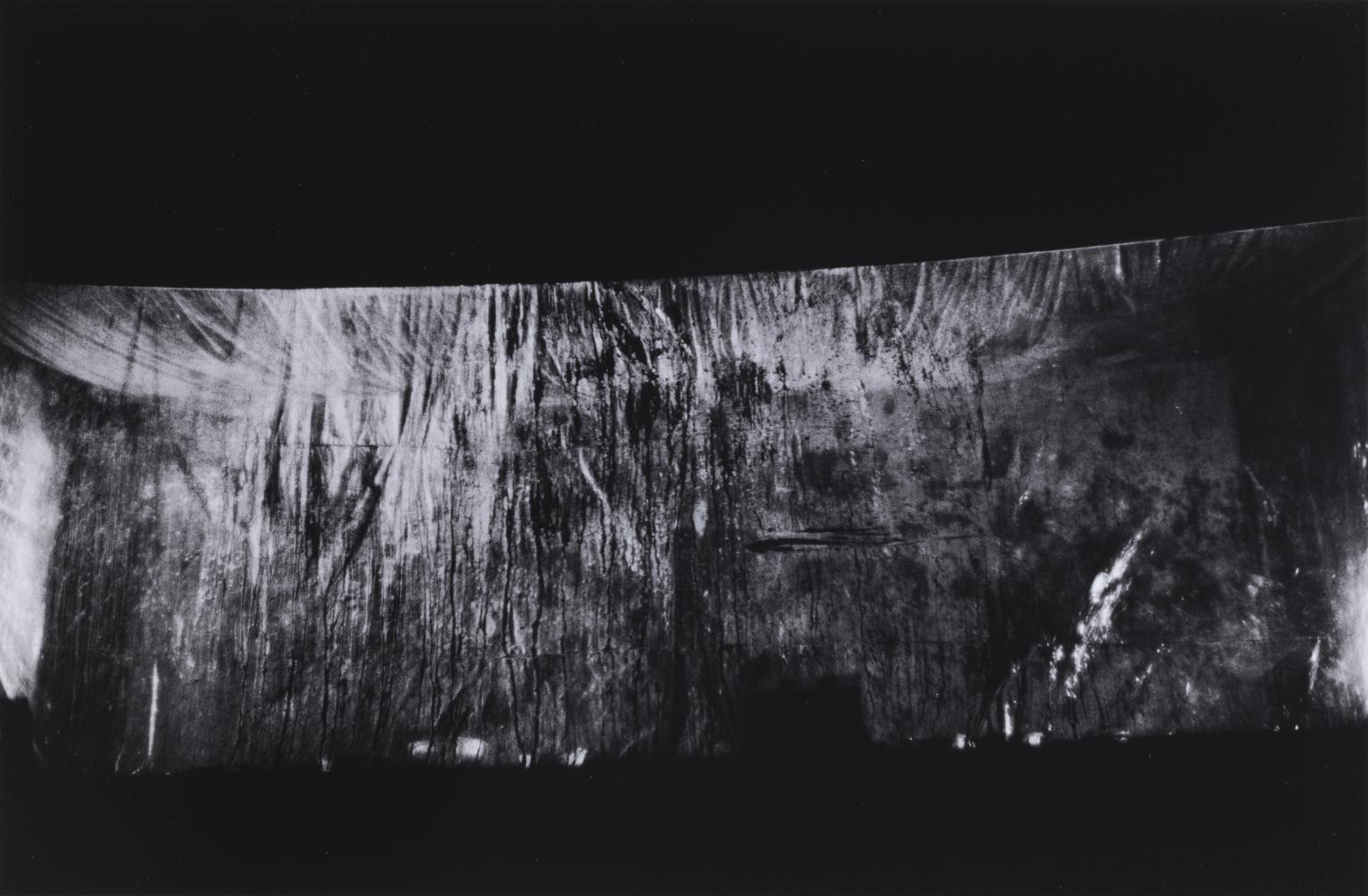
Kiyoji Otsuji, Sumi Yasuo, Painting in Space, Gutai Exhibition on the Stage 1957, printed 2012
This photograph is from the Japanese photographer Kiyoji Otsuji’s portfolio of forty-eight photographs known collectively as the Gutai Portfolio (Tate P82274–321). The portfolio comprises forty-eight black and white photographs, printed posthumously in 2012 with permission from the artist’s estate from negatives which were made between 1956 and 1957. This set is the seventh in an edition of seventeen; there also exist three artist’s proofs (other editions of the portfolio are in the collections of the Inhotim Institute in Brumadinho, Brazil and The Dallas Museum of Art). The series of images document emblematic works by members of the Japanese Gutai group, such as Tanaka Atsuko’s (born 1932) Electric Dress 1956 and Murakami Saburo’s (1925–1996) performance Passing Through 1956; such images are at times the only remaining manifestation of the often ephemeral work and actions of the Gutai artists and, as such, have been used to represent their work in publications and exhibitions about the group. The portfolio can be divided into twelve groups of images relating to performative actions that were conceived either as part of the production process for an artwork, or which constituted the work of art in itself. They relate to two landmark Gutai exhibitions: the 2nd Gutai Exhibition at Ohara Kaikan, Tokyo, circa 11–17 October 1956, and the Gutai Art on the Stage exhibition at the Sankei Kaikan halls in Osaka and Tokyo in 1957.
17/24
artworks in Gutai
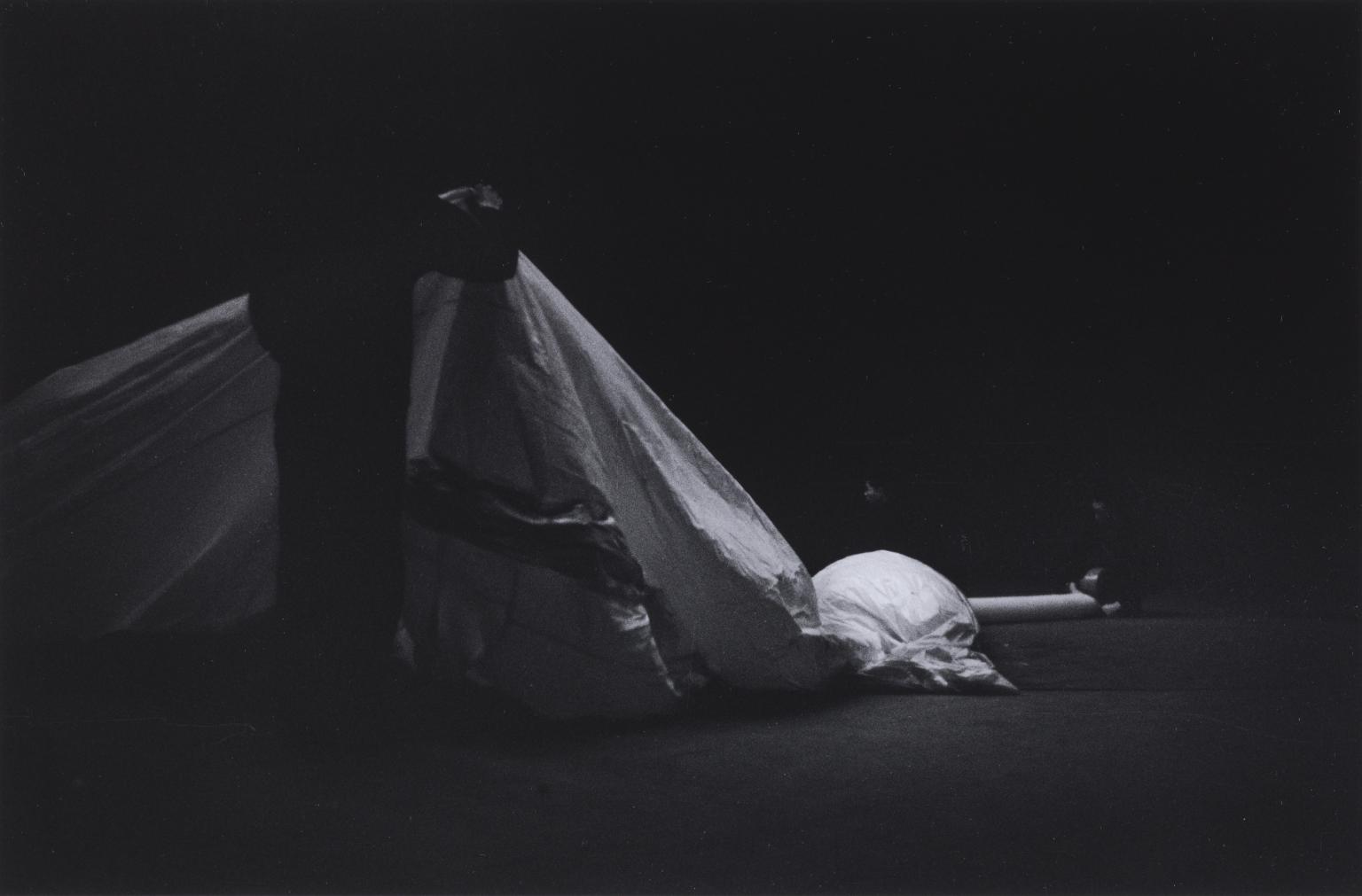
Kiyoji Otsuji, Kanayama Akira, Giant Balloon, Gutai Exhiibition on the Stage 1957, printed 2012
This photograph is from the Japanese photographer Kiyoji Otsuji’s portfolio of forty-eight photographs known collectively as the Gutai Portfolio (Tate P82274–321). The portfolio comprises forty-eight black and white photographs, printed posthumously in 2012 with permission from the artist’s estate from negatives which were made between 1956 and 1957. This set is the seventh in an edition of seventeen; there also exist three artist’s proofs (other editions of the portfolio are in the collections of the Inhotim Institute in Brumadinho, Brazil and The Dallas Museum of Art). The series of images document emblematic works by members of the Japanese Gutai group, such as Tanaka Atsuko’s (born 1932) Electric Dress 1956 and Murakami Saburo’s (1925–1996) performance Passing Through 1956; such images are at times the only remaining manifestation of the often ephemeral work and actions of the Gutai artists and, as such, have been used to represent their work in publications and exhibitions about the group. The portfolio can be divided into twelve groups of images relating to performative actions that were conceived either as part of the production process for an artwork, or which constituted the work of art in itself. They relate to two landmark Gutai exhibitions: the 2nd Gutai Exhibition at Ohara Kaikan, Tokyo, circa 11–17 October 1956, and the Gutai Art on the Stage exhibition at the Sankei Kaikan halls in Osaka and Tokyo in 1957.
18/24
artworks in Gutai
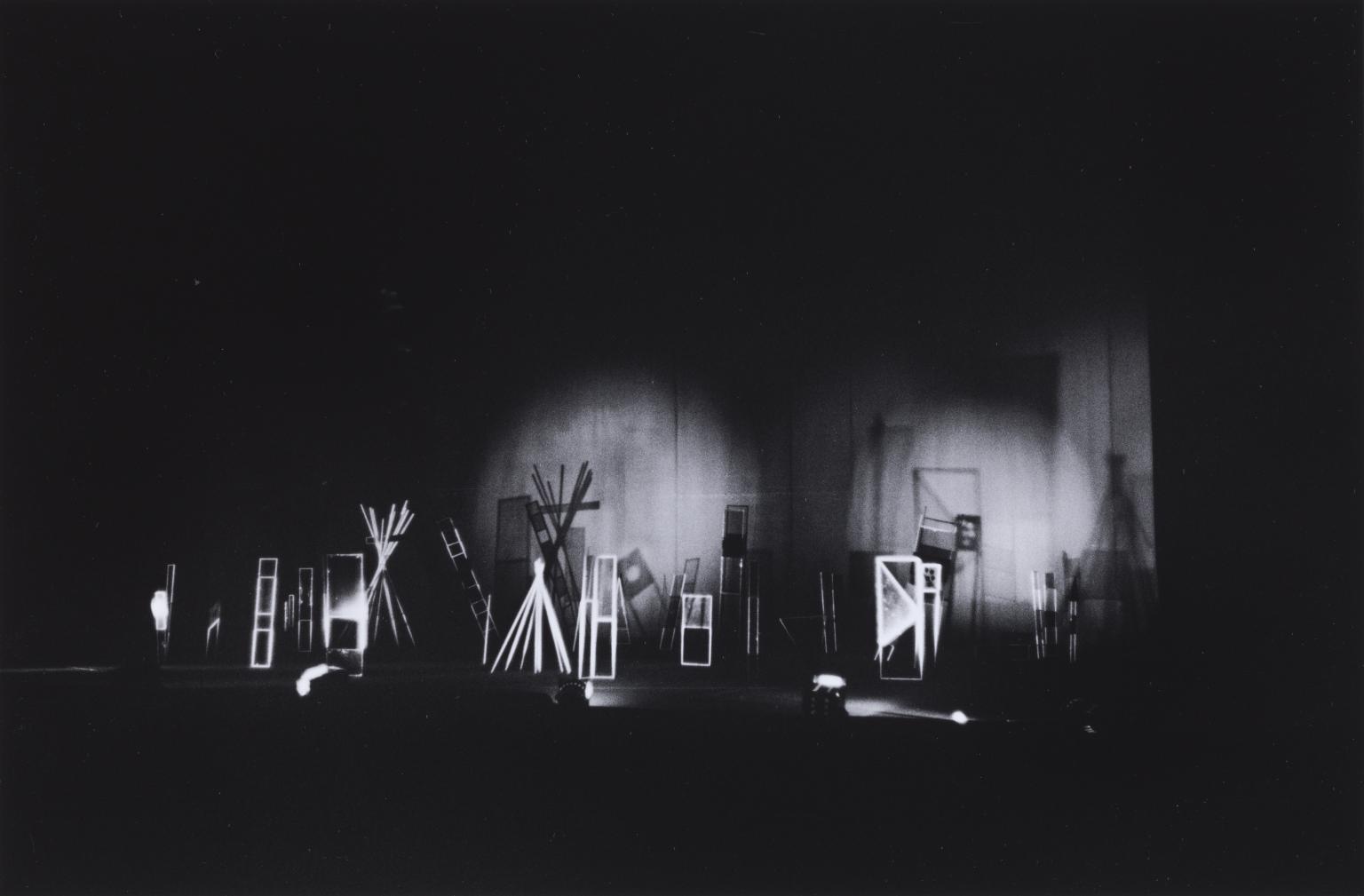
Kiyoji Otsuji, Yoshida Toshio, Image, Gutai Exhibition on the Stage 1957, printed 2012
This photograph is from the Japanese photographer Kiyoji Otsuji’s portfolio of forty-eight photographs known collectively as the Gutai Portfolio (Tate P82274–321). The portfolio comprises forty-eight black and white photographs, printed posthumously in 2012 with permission from the artist’s estate from negatives which were made between 1956 and 1957. This set is the seventh in an edition of seventeen; there also exist three artist’s proofs (other editions of the portfolio are in the collections of the Inhotim Institute in Brumadinho, Brazil and The Dallas Museum of Art). The series of images document emblematic works by members of the Japanese Gutai group, such as Tanaka Atsuko’s (born 1932) Electric Dress 1956 and Murakami Saburo’s (1925–1996) performance Passing Through 1956; such images are at times the only remaining manifestation of the often ephemeral work and actions of the Gutai artists and, as such, have been used to represent their work in publications and exhibitions about the group. The portfolio can be divided into twelve groups of images relating to performative actions that were conceived either as part of the production process for an artwork, or which constituted the work of art in itself. They relate to two landmark Gutai exhibitions: the 2nd Gutai Exhibition at Ohara Kaikan, Tokyo, circa 11–17 October 1956, and the Gutai Art on the Stage exhibition at the Sankei Kaikan halls in Osaka and Tokyo in 1957.
19/24
artworks in Gutai
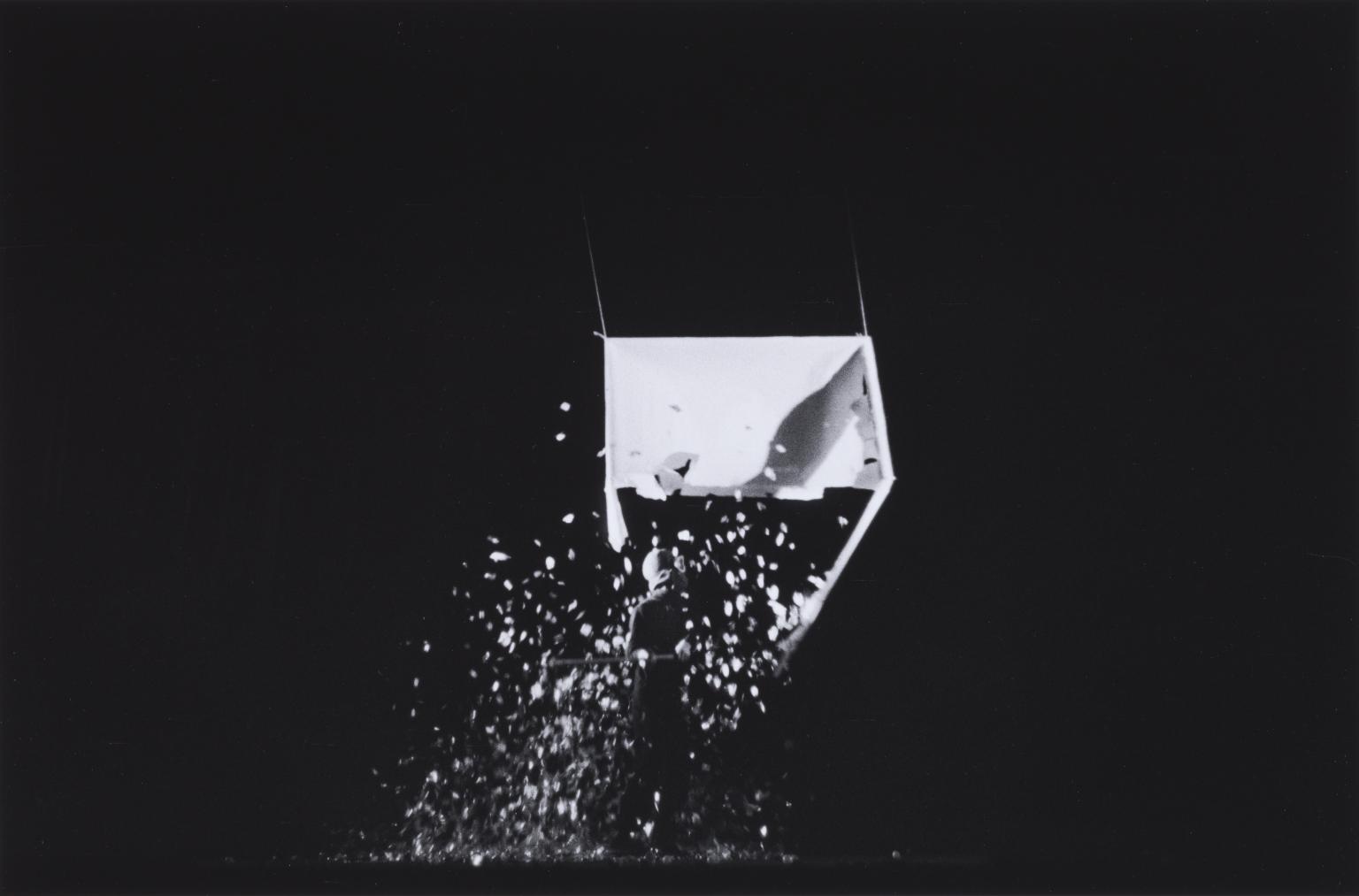
Kiyoji Otsuji, Shimamoto Shozo, Material Destruction, Gutai Exhibition on the Stage 1957, printed 2012
This photograph is from the Japanese photographer Kiyoji Otsuji’s portfolio of forty-eight photographs known collectively as the Gutai Portfolio (Tate P82274–321). The portfolio comprises forty-eight black and white photographs, printed posthumously in 2012 with permission from the artist’s estate from negatives which were made between 1956 and 1957. This set is the seventh in an edition of seventeen; there also exist three artist’s proofs (other editions of the portfolio are in the collections of the Inhotim Institute in Brumadinho, Brazil and The Dallas Museum of Art). The series of images document emblematic works by members of the Japanese Gutai group, such as Tanaka Atsuko’s (born 1932) Electric Dress 1956 and Murakami Saburo’s (1925–1996) performance Passing Through 1956; such images are at times the only remaining manifestation of the often ephemeral work and actions of the Gutai artists and, as such, have been used to represent their work in publications and exhibitions about the group. The portfolio can be divided into twelve groups of images relating to performative actions that were conceived either as part of the production process for an artwork, or which constituted the work of art in itself. They relate to two landmark Gutai exhibitions: the 2nd Gutai Exhibition at Ohara Kaikan, Tokyo, circa 11–17 October 1956, and the Gutai Art on the Stage exhibition at the Sankei Kaikan halls in Osaka and Tokyo in 1957.
20/24
artworks in Gutai
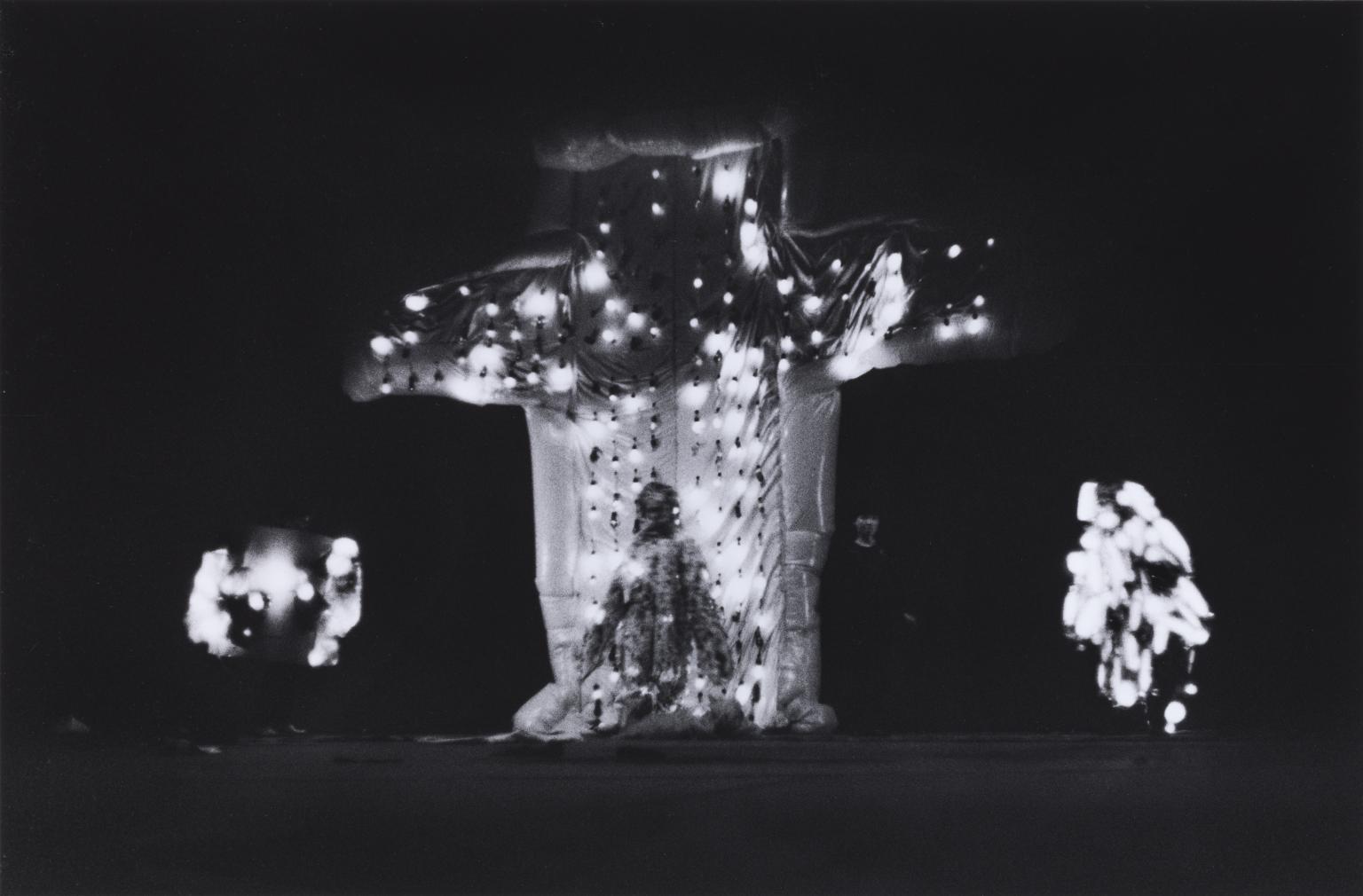
Kiyoji Otsuji, Tanaka Atsuko, Stage Clothes, Gutai Exhibition on the Stage 1957, printed 2012
This photograph is from the Japanese photographer Kiyoji Otsuji’s portfolio of forty-eight photographs known collectively as the Gutai Portfolio (Tate P82274–321). The portfolio comprises forty-eight black and white photographs, printed posthumously in 2012 with permission from the artist’s estate from negatives which were made between 1956 and 1957. This set is the seventh in an edition of seventeen; there also exist three artist’s proofs (other editions of the portfolio are in the collections of the Inhotim Institute in Brumadinho, Brazil and The Dallas Museum of Art). The series of images document emblematic works by members of the Japanese Gutai group, such as Tanaka Atsuko’s (born 1932) Electric Dress 1956 and Murakami Saburo’s (1925–1996) performance Passing Through 1956; such images are at times the only remaining manifestation of the often ephemeral work and actions of the Gutai artists and, as such, have been used to represent their work in publications and exhibitions about the group. The portfolio can be divided into twelve groups of images relating to performative actions that were conceived either as part of the production process for an artwork, or which constituted the work of art in itself. They relate to two landmark Gutai exhibitions: the 2nd Gutai Exhibition at Ohara Kaikan, Tokyo, circa 11–17 October 1956, and the Gutai Art on the Stage exhibition at the Sankei Kaikan halls in Osaka and Tokyo in 1957.
21/24
artworks in Gutai
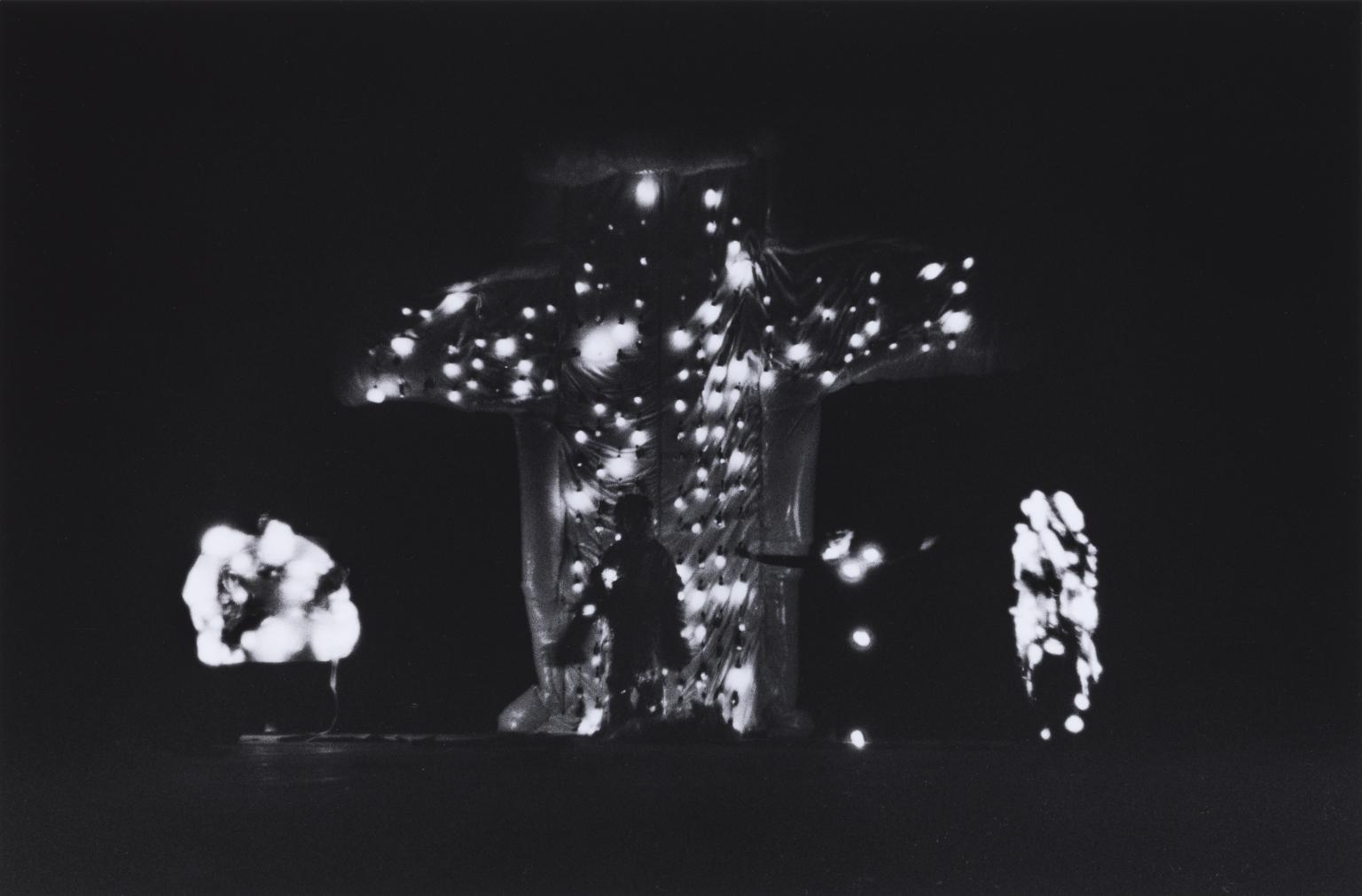
Kiyoji Otsuji, Tanaka Atsuko, Stage Clothes, Gutai Exhibition on the Stage 1957, printed 2012
This photograph is from the Japanese photographer Kiyoji Otsuji’s portfolio of forty-eight photographs known collectively as the Gutai Portfolio (Tate P82274–321). The portfolio comprises forty-eight black and white photographs, printed posthumously in 2012 with permission from the artist’s estate from negatives which were made between 1956 and 1957. This set is the seventh in an edition of seventeen; there also exist three artist’s proofs (other editions of the portfolio are in the collections of the Inhotim Institute in Brumadinho, Brazil and The Dallas Museum of Art). The series of images document emblematic works by members of the Japanese Gutai group, such as Tanaka Atsuko’s (born 1932) Electric Dress 1956 and Murakami Saburo’s (1925–1996) performance Passing Through 1956; such images are at times the only remaining manifestation of the often ephemeral work and actions of the Gutai artists and, as such, have been used to represent their work in publications and exhibitions about the group. The portfolio can be divided into twelve groups of images relating to performative actions that were conceived either as part of the production process for an artwork, or which constituted the work of art in itself. They relate to two landmark Gutai exhibitions: the 2nd Gutai Exhibition at Ohara Kaikan, Tokyo, circa 11–17 October 1956, and the Gutai Art on the Stage exhibition at the Sankei Kaikan halls in Osaka and Tokyo in 1957.
22/24
artworks in Gutai
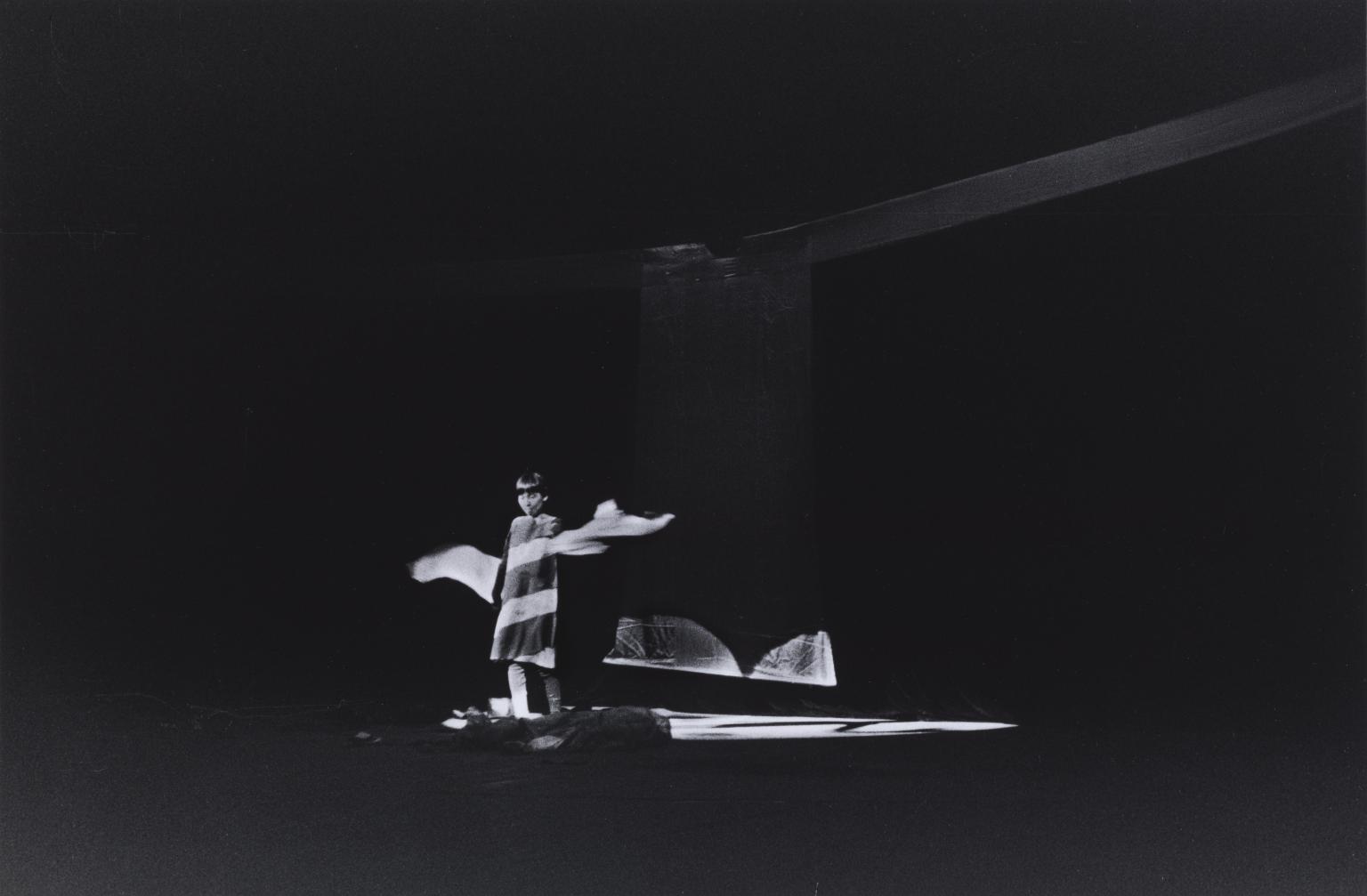
Kiyoji Otsuji, Tanaka Atsuko, Stage Clothes, Gutai Exhibition on the Stage 1957, printed 2012
This photograph is from the Japanese photographer Kiyoji Otsuji’s portfolio of forty-eight photographs known collectively as the Gutai Portfolio (Tate P82274–321). The portfolio comprises forty-eight black and white photographs, printed posthumously in 2012 with permission from the artist’s estate from negatives which were made between 1956 and 1957. This set is the seventh in an edition of seventeen; there also exist three artist’s proofs (other editions of the portfolio are in the collections of the Inhotim Institute in Brumadinho, Brazil and The Dallas Museum of Art). The series of images document emblematic works by members of the Japanese Gutai group, such as Tanaka Atsuko’s (born 1932) Electric Dress 1956 and Murakami Saburo’s (1925–1996) performance Passing Through 1956; such images are at times the only remaining manifestation of the often ephemeral work and actions of the Gutai artists and, as such, have been used to represent their work in publications and exhibitions about the group. The portfolio can be divided into twelve groups of images relating to performative actions that were conceived either as part of the production process for an artwork, or which constituted the work of art in itself. They relate to two landmark Gutai exhibitions: the 2nd Gutai Exhibition at Ohara Kaikan, Tokyo, circa 11–17 October 1956, and the Gutai Art on the Stage exhibition at the Sankei Kaikan halls in Osaka and Tokyo in 1957.
23/24
artworks in Gutai
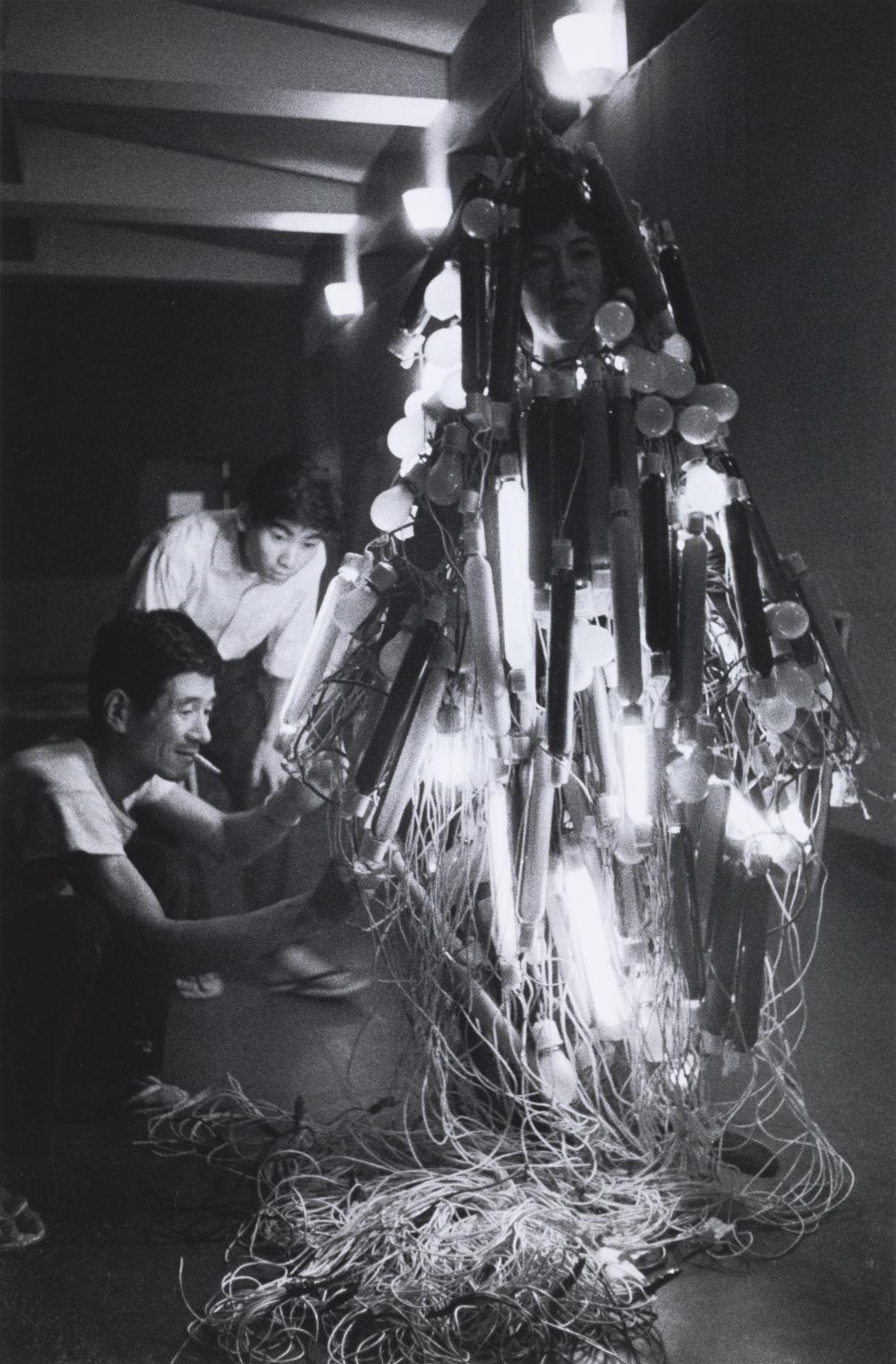
Kiyoji Otsuji, Tanaka Atsuko, Electric Dress, 2nd Gutai Exhibition 1956, printed 2012
This photograph is from the Japanese photographer Kiyoji Otsuji’s portfolio of forty-eight photographs known collectively as the Gutai Portfolio (Tate P82274–321). The portfolio comprises forty-eight black and white photographs, printed posthumously in 2012 with permission from the artist’s estate from negatives which were made between 1956 and 1957. This set is the seventh in an edition of seventeen; there also exist three artist’s proofs (other editions of the portfolio are in the collections of the Inhotim Institute in Brumadinho, Brazil and The Dallas Museum of Art). The series of images document emblematic works by members of the Japanese Gutai group, such as Tanaka Atsuko’s (born 1932) Electric Dress 1956 and Murakami Saburo’s (1925–1996) performance Passing Through 1956; such images are at times the only remaining manifestation of the often ephemeral work and actions of the Gutai artists and, as such, have been used to represent their work in publications and exhibitions about the group. The portfolio can be divided into twelve groups of images relating to performative actions that were conceived either as part of the production process for an artwork, or which constituted the work of art in itself. They relate to two landmark Gutai exhibitions: the 2nd Gutai Exhibition at Ohara Kaikan, Tokyo, circa 11–17 October 1956, and the Gutai Art on the Stage exhibition at the Sankei Kaikan halls in Osaka and Tokyo in 1957.
24/24
artworks in Gutai
Art in this room









Sorry, no image available
Sorry, no image available













You've viewed 6/24 artworks
You've viewed 24/24 artworks
